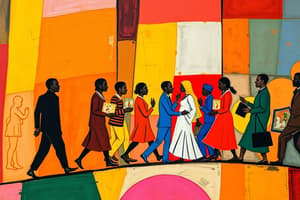Podcast
Questions and Answers
Which principle of social stratification suggests that an individual's social standing is heavily influenced by the opportunities available to them, rather than solely their innate abilities?
Which principle of social stratification suggests that an individual's social standing is heavily influenced by the opportunities available to them, rather than solely their innate abilities?
- Social stratification carries over from generation to generation.
- Social stratification is a trait of society, not simply a reflection of individual differences. (correct)
- Social stratification is universal but variable.
- Social stratification involves not just inequality but beliefs as well.
In a society with rigid social stratification, what is the likely outcome for someone born into a disadvantaged social class?
In a society with rigid social stratification, what is the likely outcome for someone born into a disadvantaged social class?
- They are likely to experience horizontal mobility.
- They have numerous opportunities for upward mobility.
- Their life chances are largely predetermined by their birth. (correct)
- They can easily acquire wealth and prestige through hard work.
Which of the following best describes how social stratification is maintained, according to the principle that 'social stratification involves not just inequality but beliefs as well'?
Which of the following best describes how social stratification is maintained, according to the principle that 'social stratification involves not just inequality but beliefs as well'?
- Through legal systems that enforce equality.
- Through collectively held beliefs that justify the existing social order. (correct)
- Through economic policies that redistribute wealth.
- Through individual efforts to challenge inequality.
An Education Supervisor leaves their job to become a School Principal. This transition involves very little change in prestige or salary. Which type of social mobility is exemplified by this scenario?
An Education Supervisor leaves their job to become a School Principal. This transition involves very little change in prestige or salary. Which type of social mobility is exemplified by this scenario?
Which characteristic is most indicative of a closed-class system?
Which characteristic is most indicative of a closed-class system?
Which statement accurately reflects the Davis-Moore thesis regarding social stratification?
Which statement accurately reflects the Davis-Moore thesis regarding social stratification?
According to the conflict perspective, what is the primary function of social stratification?
According to the conflict perspective, what is the primary function of social stratification?
Which concept, coined by Thorstein Veblen, describes the phenomenon where individuals purchase certain goods to signal their social status?
Which concept, coined by Thorstein Veblen, describes the phenomenon where individuals purchase certain goods to signal their social status?
What is the key element that distinguishes social institutions from other types of social groupings?
What is the key element that distinguishes social institutions from other types of social groupings?
In a patriarchal family structure, where does the primary authority and decision-making power reside?
In a patriarchal family structure, where does the primary authority and decision-making power reside?
Which type of marriage is characterized by one man having multiple wives?
Which type of marriage is characterized by one man having multiple wives?
What is the primary distinction between formal, informal, and non-formal education?
What is the primary distinction between formal, informal, and non-formal education?
Which of the following best describes the central tenet of animism?
Which of the following best describes the central tenet of animism?
How does the concept of 'Deism' differ from traditional monotheistic religions?
How does the concept of 'Deism' differ from traditional monotheistic religions?
Which of the following activities falls under the umbrella of 'politics as public affairs'?
Which of the following activities falls under the umbrella of 'politics as public affairs'?
Flashcards
Social Stratification
Social Stratification
Society's categorization of people based on wealth, power, and prestige, ranking them in a hierarchy.
Social Mobility
Social Mobility
Moving from one social position to another, either up, down, or sideways.
Horizontal Mobility
Horizontal Mobility
Movement within the same social class level.
Vertical Mobility
Vertical Mobility
Signup and view all the flashcards
Open Class Systems
Open Class Systems
Signup and view all the flashcards
Closed Class Systems
Closed Class Systems
Signup and view all the flashcards
Caste System
Caste System
Signup and view all the flashcards
Class System
Class System
Signup and view all the flashcards
Functionalist Perspective
Functionalist Perspective
Signup and view all the flashcards
Conflict Perspective
Conflict Perspective
Signup and view all the flashcards
Conspicuous Consumption
Conspicuous Consumption
Signup and view all the flashcards
Social Institution
Social Institution
Signup and view all the flashcards
Formal Education
Formal Education
Signup and view all the flashcards
Informal Education
Informal Education
Signup and view all the flashcards
Nonformal Education
Nonformal Education
Signup and view all the flashcards
Study Notes
- Social stratification categorizes people based on wealth, power, and prestige, ranking them hierarchically and leading to social inequality.
- It is visualized as a pyramid with layers.
Principles of Social Stratification
- Exists in every society but varies in system and effects.
- Ex: Upper/middle class in the Philippines may be lower class in affluent countries.
- Is a trait of society, not individual differences.
- One’s position is based on opportunities received, not just individual abilities.
- Carries over from generation to generation, especially in rigid systems.
- Involves not just inequality, but beliefs enforced collectively through cultural norms like religion.
Social Mobility
- This is the act of moving from one social position to another.
- Makes social class inequality seem reasonable and justifiable.
Horizontal Mobility
- Movement within a social class level.
- Ex: A principal becoming an Education Supervisor, with little change in salary or prestige.
Vertical Mobility
- Movement between social class levels, upward or downward.
- Ex: Rag-to-riches stories of business tycoons.
Classification of Stratification Systems; Open Systems
- Flexible with mobility, both upward and downward
- Achieved Status
Classification of Stratification Systems; Closed Systems
- Rigid and allows little mobility
- Ascribed Status
Major Systems of Social Stratification; Slavery
- A form where people own other people.
- Based on debt, punishment, or defeat in battle
- Slaves typically owned no property.
Major Systems of Social Stratification; Caste System
- Status determined by birth and is lifelong, with no social mobility.
- Ex: India's Thousand-Year-Old Caste System
- Ascribed status is the basis.
- Societies try to maintain boundaries through endogamy and rules about ritual pollution.
Major Systems of Social Stratification; Class System
- Primarily based on money or material possessions.
- Membership depends on wealth, economic occupation, and power.
- Allows social mobility based on achieved status.
- Initial position is based on parents' status (ascribed).
Sociological Perspectives on Social Stratification; Structural-Functionalist
- Stratification exists because it is functional to society.
- Davis-Moore Thesis: Stratification motivates people to take on difficult but important jobs.
Sociological Perspectives on Social Stratification; Conflict Perspective
- Conflict, not function, is the basis of stratification, benefitting the bourgeoisies who control resources and oppress others.
Sociological Perspectives on Social Stratification; Symbolic-Interactionist
- Explains stratification in the micro-level.
- Interaction often occurs between people of the same social class due to shared interests.
- "Conspicuous Consumption" (Veblen): Buying certain products as a social statement about status.
Social Institutions
- These are groups with established roles, functions, and norms working together to fulfill specific societal needs.
Main Social Institutions
- These are Family, Education, Religion, Economy, and Government.
Family
- Basic social institution; primary group in society.
- Varies across cultures.
- Murdock (1949) defines family by common residence, economic cooperation, and reproduction.
Family forms based on the number of people
- These are Nuclear/Traditional, Single Parent, Extended, and Childless.
Nuclear/Traditional Family
- Father, mother, and offspring.
- Father-breadwinner, mother-homemaker is typical.
Single Parent Family
- One parent raises the child.
- Support may come from relatives and caregivers.
Extended Family
- Includes the nuclear family plus the parents of either or both spouses, common in Asia.
Childless Family
- A couple without children.
Authority and Power Structure of the Family
- Varies by society.
Patriarchal Family
- Decision-making power lies with the man
- Eldest son may take leadership in the man's absence.
Matriarchal Family
- Female-headed or “matrifocal“family; authority is vested in the woman.
Egalitarian Family
- Power and decision-making authority are equally distributed between the husband and wife.
Marriage
- An important part of the family is marriage.
Traditional Definition
- A union between a man and a woman where children are legitimate offspring of both.
Current Definition
- Assertion that the idea of marriage has changed.
Family Code of the Philippines (EO 209 s. July 6, 1987)
- Marriage is a special contract of permanent union between a man and a woman entered into in accordance with law for conjugal and family life.
Types of Marriage; Monogamy
- A form of marriage between one man and one woman.
Types of Marriage; Polygamy
- A form of marriage where one person has more than one mate.
Polygamy Sub-Divisions; Polygyny
- A man has more than one wife.
Polygamy Sub-Divisions; Polyandry
- A woman has more than one husband.
Education
- Processes of acquiring knowledge, skills, & values allowing people to participate in society.
- It occurs in many forms of environments
Formal Education
- An institutional activity with a chronologically graded structure; uniform, subject-oriented, full time.
Elementary Education
- It is the first part of educational system concerned with basic education.
Secondary Education
- Continues basic education and adds employable skills.
Tertiary Education
- Most institutions are typically regulated by the Commission on Higher Education.
Vocational Education
- Accredited private institutions offer technical skills.
Informal Education
- Life-long process of self-learning
Nonformal Education
- Flexible and diversified in content and method, focusing on learner participation
Religion
- Defined by Durkheim as a unified set of beliefs and practices related to sacred things that unite believers into a moral community (Church).
Elements of Religion
- Belief system, moral guidelines, rituals, community of believers, tangible objects, etc.
Animism
- Belief that a soul or spirit exists in every object, even inanimate ones.
Theism
- Any belief system incorporating the existence of a deity.
Monotheism
- Recognizes only one deity.
Deism
- At least one deity created the world but doesn't alter the original plan.
Polytheism
- Includes faith traditions involving more than one deity. Includes types of hard and soft.
Politics and State
- Politics includes activities related to government, public affairs, compromise, consensus, and power.
- Involves the structure, function, and practice of government.
- Concerns the management of public interest (laws, welfare, etc.).
- Attempts to resolve conflict through discussion, compromise, and consensus.
- Involves the use of authority and influence for various purposes.
Political Organization
- Evolve through time as societies evolve.
Bands
- Least complex; no rigid governance or structured leadership.
Tribes
- Kinship marked by loyalty per family; less mobile than bands.
Chiefdoms
- Fulltime leadership roles, everyone ranked relative to the chief.
States
- Appeared in societies with large-scale intensive agriculture.
State
- Political/legal group with a community occupying territory, having its own government, and enjoying freedom.
Elements of a State
- These are People, Territory, Government, and Sovereignty.
Government officials
- They functions to ensure all affairs are managed.
People
- A population with enough members to perform the state's functions and the capacity to procreate.
Sovereignty
- Internal (domestic) and external (international).
Divine Origin Theory
- State originates from God's will, with appointed leaders.
Force Theory
- State emerges from warfare and conquest, where conquerors rule.
Evolution Theory
- State develops from families grouping into bigger communities.
Social Contract Theory
- State is created through an agreement where people lessen freedoms in exchange for protection.
Inherent Powers of State
- Police Power: promotes public welfare.
- Eminent Domain: power of taking property for public use.
- Taxation: power to impose taxes for public spending.
Authority
- Powers include promoting public welfare, payment of compensation, and used public expenditure.
- Government is the legal component which enforces this.
Traditional Authority
- Based on acceptance of traditions.
Rational Authority
- Based on acceptance of laws.
Charismatic Authority
- Based on exceptional leader.
Coercive Authority
- Based on the use of force.
Authority powers
- Can only be exercised by the Government and is justified by two philosophies which are Salus populi suprema lex and Sic utere ut alienum non laedas.
Government
- A group of people who rule or run the administration.
Governance
- It is the exercise of power/authority by a political leader
Functions of Government
- Constituent functions and ministrant functions.
Ministrant Functions
- Undertaken to advance the general interests of society.
Constituent Functions
- Includes all compulsory very bounds, from keeping of order, providing protection, and fixing of legal relations.
The Constitution
- Fundamental organic law containing principles of government.
Origin of the Preamble
- From "preambulare," meaning "to walk before."
Branches of Government
- Executive, Legislative, and Judicial.
Powers of the President and Vice President
- Includes control of executive branches, supervisions, appointments, military, borrowing, budget, and diplomatic powers.
Three Branches of Government: Executive
- Carries out enacted laws; composed of president, vice president, and cabinet.
Three Branches of Government: Legislative
- Lawmaking body with constitutional authority to pass, repeal, or change laws.
- In the philippines it is bicameral (senate and house)
Three Branches of Government: Judicial
- Interprets the laws.
- Hierarchy is a universal feature of judicial institutions.
Levels of Judicial Courts
- Multiple where some courts are explicitly subordinate to the others.
Senate
- 24 Senators
- Elected at is large qualified.
House of Representatives
- 250 Seats, divided into districts.
Congress power
- Includes Legislative, Impeachment, of inquiry, and appropriation.
Senate requirements
- 35 Years old, registered voted, able to read/write, nature-born, resident of Philippines.
House of Representatives requirements
- 25 Years old, registered voted, able to read/write, nature-born, resident of Philippines.
The Judiciary
- Hierarchical composed of municipal, regional, and Supreme courts.
Supreme Court
- The highest court in the Philippines.
Regional Trial Courts
- Resolve appeals over all cases decided by Metropolitan Trial Courts
Jurisdiction explained
- Defined as the power of the courts to rule on and decide cases
Aristotle's Forms of Government
- Stressed that forms of Government have two variations, positive and negative.
Monarchy
- Government with a single ruler for the benefit of people.
Tyranny
- A ruler in a government who rules for his own beliefs and ego, he is the opposite of a Monarchy..
Aristocracy
- Government with power in the best of the community, the best qualified to rule.
Oligarchy
- The wealth and social few believe wealth should be most important, and they use the Government for economic things
Democracy
- Power of the people
Unitary Government
- Control of national and local.
Federal Government
- Power is divided among two sets of organs.
Democratic Government
- Government de jure or de facto.
Unitary - governmental powers are concentrated.
- only minimal power is granted on the local governments.
Federal
- Government with powers shared.
Basic Levels of Government
- national and local government.
Authoritarianism
- A form of government that limits freedoms.
Totalitarianism
- A more extreme form that controls personal freedoms.
Studying That Suits You
Use AI to generate personalized quizzes and flashcards to suit your learning preferences.




